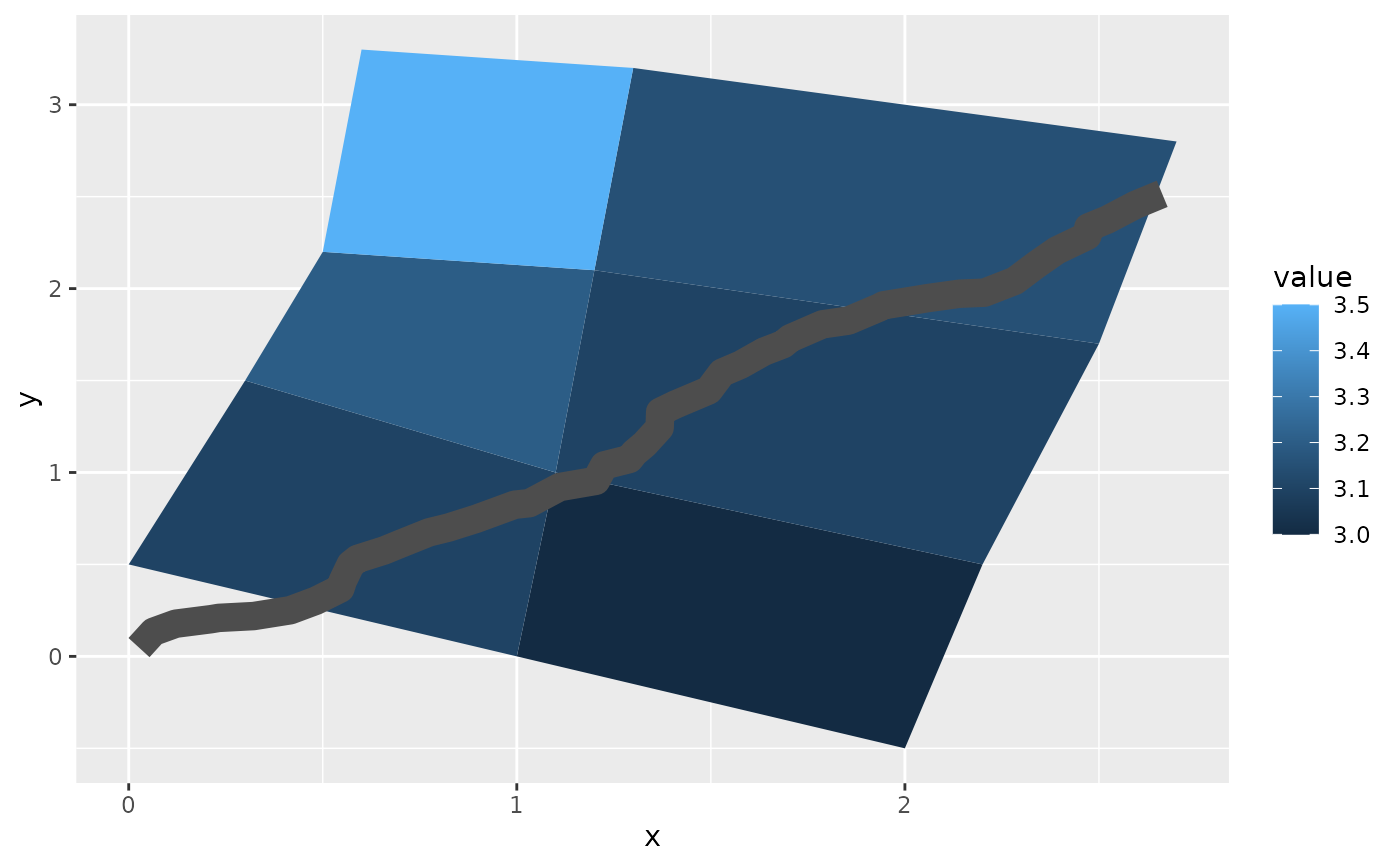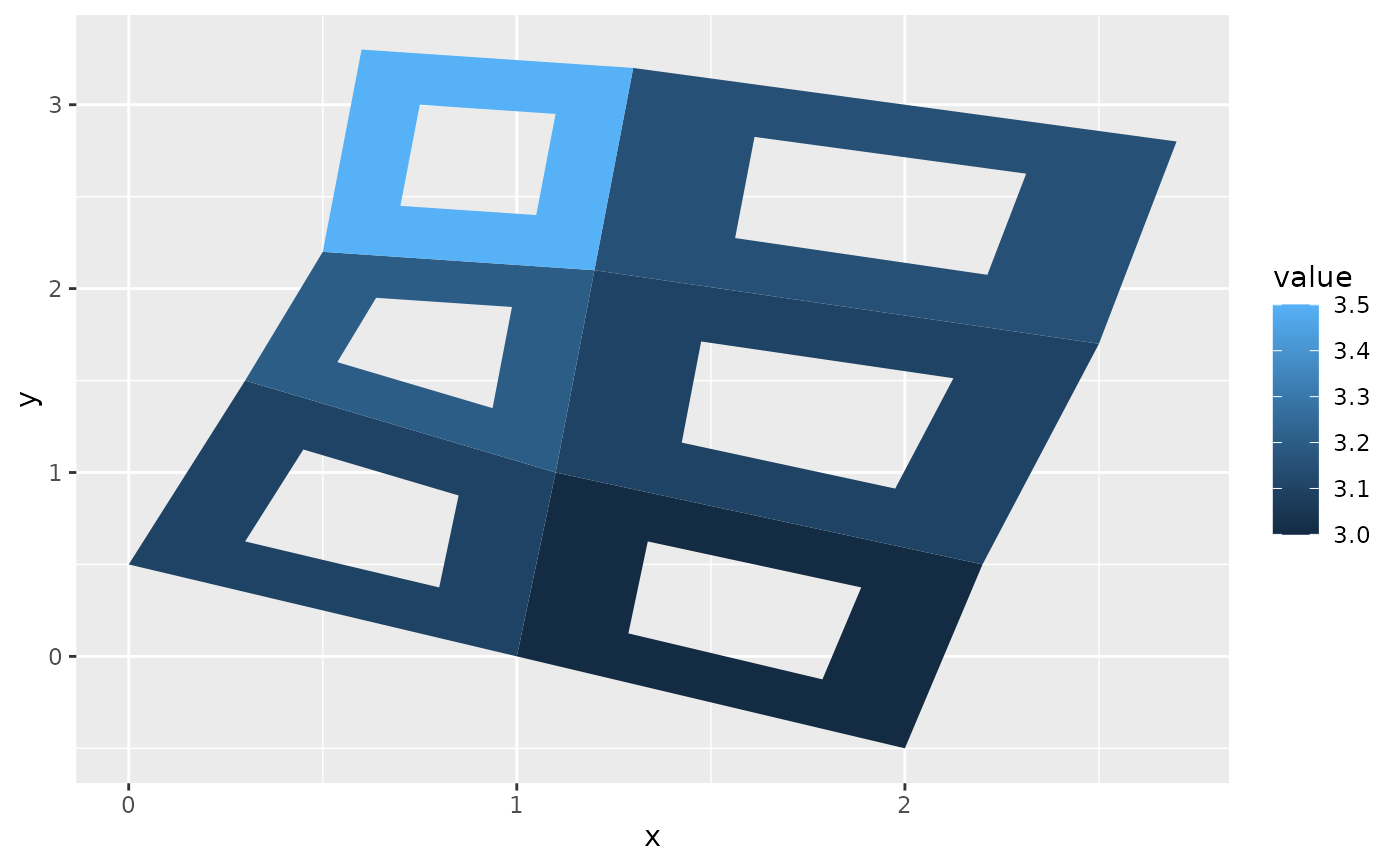Polygons are very similar to paths (as drawn by geom_path())
except that the start and end points are connected and the inside is
coloured by fill. The group aesthetic determines which cases
are connected together into a polygon. From R 3.6 and onwards it is possible
to draw polygons with holes by providing a subgroup aesthetic that
differentiates the outer ring points from those describing holes in the
polygon.
Usage
geom_polygon(
mapping = NULL,
data = NULL,
stat = "identity",
position = "identity",
...,
rule = "evenodd",
lineend = "butt",
linejoin = "round",
linemitre = 10,
na.rm = FALSE,
show.legend = NA,
inherit.aes = TRUE
)Arguments
- mapping
Set of aesthetic mappings created by
aes(). If specified andinherit.aes = TRUE(the default), it is combined with the default mapping at the top level of the plot. You must supplymappingif there is no plot mapping.- data
The data to be displayed in this layer. There are three options:
If
NULL, the default, the data is inherited from the plot data as specified in the call toggplot().A
data.frame, or other object, will override the plot data. All objects will be fortified to produce a data frame. Seefortify()for which variables will be created.A
functionwill be called with a single argument, the plot data. The return value must be adata.frame, and will be used as the layer data. Afunctioncan be created from aformula(e.g.~ head(.x, 10)).- stat
The statistical transformation to use on the data for this layer. When using a
geom_*()function to construct a layer, thestatargument can be used to override the default coupling between geoms and stats. Thestatargument accepts the following:A
Statggproto subclass, for exampleStatCount.A string naming the stat. To give the stat as a string, strip the function name of the
stat_prefix. For example, to usestat_count(), give the stat as"count".For more information and other ways to specify the stat, see the layer stat documentation.
- position
A position adjustment to use on the data for this layer. This can be used in various ways, including to prevent overplotting and improving the display. The
positionargument accepts the following:The result of calling a position function, such as
position_jitter(). This method allows for passing extra arguments to the position.A string naming the position adjustment. To give the position as a string, strip the function name of the
position_prefix. For example, to useposition_jitter(), give the position as"jitter".For more information and other ways to specify the position, see the layer position documentation.
- ...
Other arguments passed on to
layer()'sparamsargument. These arguments broadly fall into one of 4 categories below. Notably, further arguments to thepositionargument, or aesthetics that are required can not be passed through.... Unknown arguments that are not part of the 4 categories below are ignored.Static aesthetics that are not mapped to a scale, but are at a fixed value and apply to the layer as a whole. For example,
colour = "red"orlinewidth = 3. The geom's documentation has an Aesthetics section that lists the available options. The 'required' aesthetics cannot be passed on to theparams. Please note that while passing unmapped aesthetics as vectors is technically possible, the order and required length is not guaranteed to be parallel to the input data.When constructing a layer using a
stat_*()function, the...argument can be used to pass on parameters to thegeompart of the layer. An example of this isstat_density(geom = "area", outline.type = "both"). The geom's documentation lists which parameters it can accept.Inversely, when constructing a layer using a
geom_*()function, the...argument can be used to pass on parameters to thestatpart of the layer. An example of this isgeom_area(stat = "density", adjust = 0.5). The stat's documentation lists which parameters it can accept.The
key_glyphargument oflayer()may also be passed on through.... This can be one of the functions described as key glyphs, to change the display of the layer in the legend.
- rule
Either
"evenodd"or"winding". If polygons with holes are being drawn (using thesubgroupaesthetic) this argument defines how the hole coordinates are interpreted. See the examples ingrid::pathGrob()for an explanation.- lineend
Line end style (round, butt, square).
- linejoin
Line join style (round, mitre, bevel).
- linemitre
Line mitre limit (number greater than 1).
- na.rm
If
FALSE, the default, missing values are removed with a warning. IfTRUE, missing values are silently removed.- show.legend
logical. Should this layer be included in the legends?
NA, the default, includes if any aesthetics are mapped.FALSEnever includes, andTRUEalways includes. It can also be a named logical vector to finely select the aesthetics to display. To include legend keys for all levels, even when no data exists, useTRUE. IfNA, all levels are shown in legend, but unobserved levels are omitted.- inherit.aes
If
FALSE, overrides the default aesthetics, rather than combining with them. This is most useful for helper functions that define both data and aesthetics and shouldn't inherit behaviour from the default plot specification, e.g.annotation_borders().
See also
geom_path() for an unfilled polygon,
geom_ribbon() for a polygon anchored on the x-axis
Aesthetics
geom_polygon() understands the following aesthetics. Required aesthetics are displayed in bold and defaults are displayed for optional aesthetics:
| • | x | |
| • | y | |
| • | alpha | → NA |
| • | colour | → via theme() |
| • | fill | → via theme() |
| • | group | → inferred |
| • | linetype | → via theme() |
| • | linewidth | → via theme() |
| • | subgroup | → NULL |
Learn more about setting these aesthetics in vignette("ggplot2-specs").
Examples
# When using geom_polygon, you will typically need two data frames:
# one contains the coordinates of each polygon (positions), and the
# other the values associated with each polygon (values). An id
# variable links the two together
ids <- factor(c("1.1", "2.1", "1.2", "2.2", "1.3", "2.3"))
values <- data.frame(
id = ids,
value = c(3, 3.1, 3.1, 3.2, 3.15, 3.5)
)
positions <- data.frame(
id = rep(ids, each = 4),
x = c(2, 1, 1.1, 2.2, 1, 0, 0.3, 1.1, 2.2, 1.1, 1.2, 2.5, 1.1, 0.3,
0.5, 1.2, 2.5, 1.2, 1.3, 2.7, 1.2, 0.5, 0.6, 1.3),
y = c(-0.5, 0, 1, 0.5, 0, 0.5, 1.5, 1, 0.5, 1, 2.1, 1.7, 1, 1.5,
2.2, 2.1, 1.7, 2.1, 3.2, 2.8, 2.1, 2.2, 3.3, 3.2)
)
# Currently we need to manually merge the two together
datapoly <- merge(values, positions, by = c("id"))
p <- ggplot(datapoly, aes(x = x, y = y)) +
geom_polygon(aes(fill = value, group = id))
p
 # Which seems like a lot of work, but then it's easy to add on
# other features in this coordinate system, e.g.:
set.seed(1)
stream <- data.frame(
x = cumsum(runif(50, max = 0.1)),
y = cumsum(runif(50,max = 0.1))
)
p + geom_line(data = stream, colour = "grey30", linewidth = 5)
# Which seems like a lot of work, but then it's easy to add on
# other features in this coordinate system, e.g.:
set.seed(1)
stream <- data.frame(
x = cumsum(runif(50, max = 0.1)),
y = cumsum(runif(50,max = 0.1))
)
p + geom_line(data = stream, colour = "grey30", linewidth = 5)
 # And if the positions are in longitude and latitude, you can use
# coord_map to produce different map projections.
if (packageVersion("grid") >= "3.6") {
# As of R version 3.6 geom_polygon() supports polygons with holes
# Use the subgroup aesthetic to differentiate holes from the main polygon
holes <- do.call(rbind, lapply(split(datapoly, datapoly$id), function(df) {
df$x <- df$x + 0.5 * (mean(df$x) - df$x)
df$y <- df$y + 0.5 * (mean(df$y) - df$y)
df
}))
datapoly$subid <- 1L
holes$subid <- 2L
datapoly <- rbind(datapoly, holes)
p <- ggplot(datapoly, aes(x = x, y = y)) +
geom_polygon(aes(fill = value, group = id, subgroup = subid))
p
}
# And if the positions are in longitude and latitude, you can use
# coord_map to produce different map projections.
if (packageVersion("grid") >= "3.6") {
# As of R version 3.6 geom_polygon() supports polygons with holes
# Use the subgroup aesthetic to differentiate holes from the main polygon
holes <- do.call(rbind, lapply(split(datapoly, datapoly$id), function(df) {
df$x <- df$x + 0.5 * (mean(df$x) - df$x)
df$y <- df$y + 0.5 * (mean(df$y) - df$y)
df
}))
datapoly$subid <- 1L
holes$subid <- 2L
datapoly <- rbind(datapoly, holes)
p <- ggplot(datapoly, aes(x = x, y = y)) +
geom_polygon(aes(fill = value, group = id, subgroup = subid))
p
}

